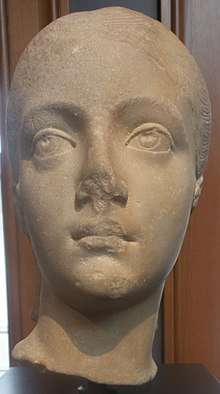Fulvia Plautilla
Publia Fulvia Plautilla, Fulvia Plautilla or Plautilla (c. 185/around 188/189 – 211) was the wife of the Roman emperor Caracalla, her paternal second cousin. After her father was condemned for treason, she was exiled and eventually killed, possibly on Caracalla's orders. She was related to Julius Caesar's first wife Cornelia.
| Fulvia Plautilla | |||||||||
|---|---|---|---|---|---|---|---|---|---|
| Augusta | |||||||||
 Fulvia Plautilla on a denarius. | |||||||||
| Empress of the Roman Empire | |||||||||
| Reign | 202-205 (alongside Julia Domna) | ||||||||
| Predecessor | Julia Domna | ||||||||
| Successor | Julia Domna | ||||||||
| Born | c. 185 Rome | ||||||||
| Died | 211 Lipari | ||||||||
| Spouse | Emperor Caracalla | ||||||||
| Issue | Unknown daughter | ||||||||
| |||||||||
| Father | Consul Gaius Fulvius Plautianus | ||||||||
| Mother | Hortensia | ||||||||
Birth and family
Plautilla was born and raised in Rome. She belonged to the gens Fulvia of ancient Rome. The Fulvius family was of plebeian origin, came from Tusculum, Italy and had been active in politics since the Roman Republic. Her mother was named Hortensia; her father was Gaius Fulvius Plautianus, the Commander of the Praetorian Guard, consul, paternal first cousin and close ally to Roman Emperor Lucius Septimius Severus (the father of Caracalla). She also had a brother, Gaius Fulvius Plautius Hortensianus.
Severus and Plautianus arranged for Plautilla and Caracalla to be married in a lavish ceremony in April 202. The forced marriage proved to be very unhappy; Caracalla despised her. According to Cassius Dio, Plautilla had a profligate character.
According to numismatic evidence, Plautilla bore Caracalla a daughter whose name is unknown in 204. In the same year, her father-in-law ordered the erection of the Arch of Septimius Severus, honoring himself and his family, including his wife, Empress Julia Domna, Caracalla, Plautilla and her brother-in-law Publius Septimius Geta.

Exile
On January 22, 205 Gaius Fulvius Plautianus was executed for treachery and his family properties were confiscated. Plautilla and her brother were exiled by Caracalla to Sicily and then to Lipari. They were treated very harshly and were eventually strangled, possibly on Caracalla's orders after the death of Septimius Severus on February 4, 211.
Contemporary depictions
Coins bearing her image that have survived are mainly from the reign of her father-in-law. They are inscribed Plautilla Augusta or Plautillae Augustae.
A marble bust of Fulvia Plautilla is in the Louvre.[1]
The Solinjanka or Salonitanka, meaning "woman from the city of Solin (ancient Salona)", one of the most important Roman portraits found in Croatia, is believed to depict Plautilla at a young age.[2] [3] Originally found in Salona, it is now kept in the Archaeological museum in Zagreb.
References
- History of Rome and of the Roman people (from its origin to the invasion of the barbarians), Victor Duruy and John Pentland Mahaffey, C.F. Jewett Publishing Company, 1883, pg. 535.
- The Greek and Roman Collection Archived 2013-02-14 at the Wayback Machine, Web page of Archaeological museum in Zagreb.
- Plautilla and the Fate of a Princess, Archaeologia Adriatica 11 (2008), 473-488 (Article in Croatian; showing portrait).
External links
- http://www.treasurerealm.com/coinpapers/romanemperors/plautilla.html
- https://web.archive.org/web/20070928092559/http://vessels-of-time.com/women_of_rome.htm
- http://www.roman-emperors.org/caracala.htm#Note_pfp
- https://web.archive.org/web/20070907023111/http://www.forumancientcoins.com/historia/coins/r4/r1461.htm
- http://penelope.uchicago.edu/Thayer/E/Gazetteer/Places/Europe/Italy/Lazio/Roma/Rome/_Texts/PLATOP*/Arcus_Argentariorum.html
- http://www.trajancoins.com/plautilla.htm
- "Dictionary of Greek and Roman Biography and Mythology, p. 405". Archived from the original on 27 February 2015.
- Marble portrait of Plautilla kept in Archaeological museum in Zagreb.
| Royal titles | ||
|---|---|---|
| Preceded by Julia Domna |
Empress of Rome 202–205 with Julia Domna (202–205) |
Succeeded by Julia Domna |